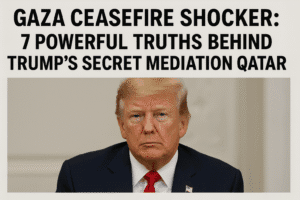Gaza Ceasefire Shocker: 7 Powerful Truths Behind Trump’s Secret Mediation with Qatar
Former U.S. President Donald Trump’s reported meeting with Qatar’s Prime Minister Sheikh Mohammed bin Abdulrahman al-Thani signals a behind-the-scenes effort to influence Gaza ceasefire talks amid ongoing deadlock. With Qatar hosting key negotiations and holding ties to Hamas, Trump’s unofficial role may test Hamas’ flexibility and reassert his foreign policy relevance. Talks remain stalled over Israel’s security control and Hamas’ demands for full withdrawal.
The worsening humanitarian crisis amplifies pressure for resolution. Meanwhile, Trump’s involvement risks complicating U.S. diplomacy while possibly swaying Netanyahu. Despite lacking formal power, Trump’s presence highlights the desperation for progress where official efforts have faltered.

Gaza Ceasefire Shocker: 7 Powerful Truths Behind Trump’s Secret Mediation with Qatar
Former U.S. President Donald Trump is reportedly set to meet Qatar’s Prime Minister Sheikh Mohammed bin Abdulrahman al-Thani on Wednesday. While unofficial, this discussion carries weight. Qatar, a critical mediator hosting Hamas-Israel talks in Doha, possesses unique channels to Hamas leadership. Trump, despite lacking current authority, retains significant political influence and relationships with key regional players, including Israel’s leadership.
Why This Matters Now:
- Stalled Negotiations: Talks have deadlocked over core issues:
- The Withdrawal Gap: Hamas demands a complete Israeli withdrawal from Gaza and a permanent ceasefire. Israel insists on maintaining security control and the right to resume operations post-hostage return.
- “Endgame” Ambiguity: The proposed 60-day pause postpones the hardest question: What happens after? Neither side agrees on Gaza’s future governance or security.
- Humanitarian Catastrophe: Over 58,000 reported Palestinian deaths, mass displacement, and famine-like conditions create urgent moral and political pressure. Each stalled week deepens the suffering and radicalization risk.
- Trump’s Unconventional Role: His involvement, while legally symbolic, signals:
- Potential attempts to influence Netanyahu (historically aligned with Trump).
- A desire to project foreign policy relevance ahead of the U.S. election.
- Leveraging Qatar’s unique access to test Hamas’ flexibility informally.
The Geopolitical Tightrope:
- Qatar’s Balancing Act: Doha walks a fine line – maintaining its vital mediation role for the U.S. and Israel while facing domestic and regional pressure for its Hamas ties. Success here is crucial for its international standing.
- U.S. Diplomatic Challenges: The Biden administration’s official efforts remain primary, but Trump’s parallel engagement risks complicating messaging or offering Hamas/Israel alternative avenues, potentially undermining unity.
- Iran’s Shadow: The expected discussion on reviving U.S.-Iran nuclear talks (also mentioned in the report) is intrinsically linked. Progress on Gaza could ease regional tensions, facilitating nuclear diplomacy. Conversely, escalation would poison the well.
Beyond the Headlines: Key Unanswered Questions
- Can Trump Move Netanyahu? Will Israeli PM Netanyahu, facing far-right coalition pressure, entertain concessions pushed by an ally like Trump that he rejects from Biden?
- Hamas’ Calculus: Does Hamas see Trump’s involvement as a path to better terms, or merely a propaganda opportunity? Is their Doha delegation truly empowered to compromise?
- The “Day After” Void: Even if a 60-day pause is achieved, the absence of a credible plan for Gaza’s governance, security, and reconstruction remains a critical failure point. Who fills this vacuum?
The Stakes:
This meeting, while not official diplomacy, underscores the desperate search for leverage in a conflict where traditional channels have repeatedly failed. The immediate goals are clear:
- Secure the release of Israeli hostages.
- Achieve a sustained ceasefire to flood Gaza with aid.
- Create space for a political solution.
Yet, the fundamental obstacles – mutual existential distrust, incompatible end-state visions, and the sheer scale of devastation – remain daunting. Trump’s foray highlights the crisis’s intractability and the willingness of actors to explore even unconventional paths, but it risks becoming another layer of complexity rather than a breakthrough catalyst.
Conclusion:
The Trump-Qatar meeting is less about immediate deal-making and more about probing possibilities and exerting influence behind the scenes. Its significance lies in recognizing the limitations of current formal negotiations and the lengths stakeholders will go to alter the trajectory. True progress, however, still hinges on the warring parties making painful compromises the world has yet to witness. The lives of hostages and civilians, alongside regional stability, hang precariously in the balance.
You must be logged in to post a comment.